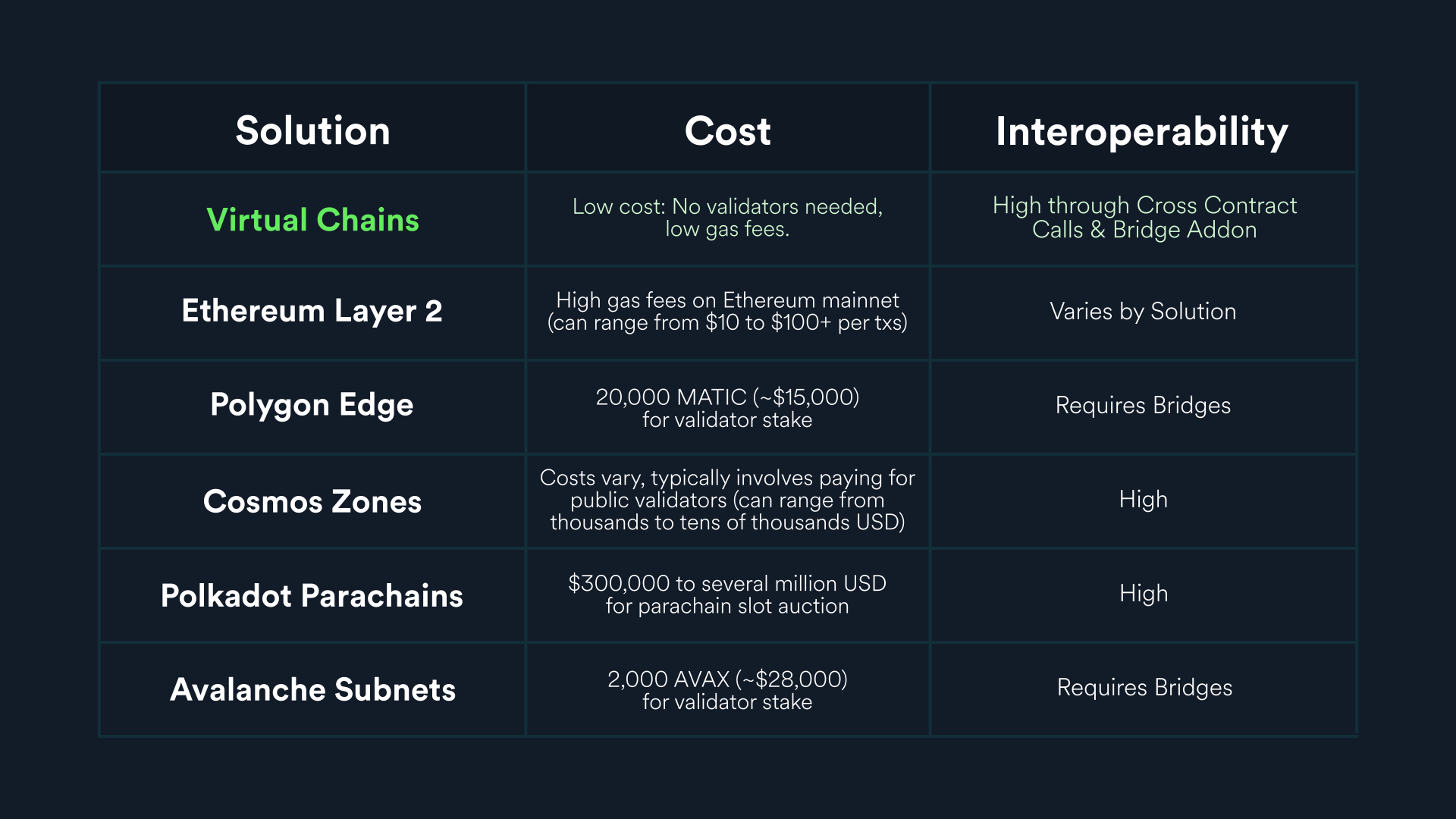From Weeks to Minutes: Supercharging dApp Development with Virtual Chains
An Introduction to Virtual Chains
TL;DR:
- Traditional AppChains such as rollups, sidechains, parachains, suffer from major shortcomings such as limited composability, limited tooling, long development time, particularly for building necessary integrations, as well as challenges with interoperability.
- Virtual Chains emerge as an alternative to these shortcomings; as they are ready-made, fully customizable and interconnected blockchain instances.
Just a few years ago, app developers had limited options for deploying their applications, primarily choosing between Ethereum, Solana, Cosmos, or a few other Layer-1 chains. Rollups were not yet operational, making the advantages of building on a Layer-1 clear and straightforward: better throughput and lower fees. However, the landscape has dramatically evolved with in a short span of time with the rise of AppChains introducing a myriad of new approaches to enhance app development.
However, the host of new approaches currently available in the market present some substantial shortcomings, namely, limited composability and atomicity, resulting in isolated ecosystems and liquidity fragmentation. Moreover, they also require substantial developer effort as they need to be built from scratch, often with very limited tooling, making them very expensive and time consuming to deploy.
These limitations led to the development of Virtual Chains, a new approach that aims to combine the best of both worlds. Deployed as a smart contract on top of the NEAR Protocol base layer, Virtual Chains emulates a blockchain environment, providing customizable and interconnected blockchain instances. Since Virtual Chains inherit the infrastructure of the base layer, it is able to offer from day one the necessary tools and infrastructure needed for dApps without extensive development.
As we will see in the next section, Virtual Chain is the only option in the market that to this day allows developers to substantially cut costs of development and infrastructure and reduce their go-to-market time while still maintaining all the benefits of traditional AppChains.

Competitive Advantages of Ready Made Blockchain Solutions
Deploying traditional AppChains involves a lengthy process of building infrastructure from scratch. This requires developers to spend many hours setting up all necessary components to infrastructural challenges and piling up costs.
Setting up validators alone can cost thousands of dollars and require extensive specialized knowledge, and these are only one of the many components needed to launch a dApp. Rebuilding the blockchain infrastructure also involves ensuring interoperability with other blockchains,usually through the building of bridges, setting up an onramp solution, getting listed on CEXs, and deploying third party services such as Oracles, to name the most common. Needless to say, this process diverts attention and resources away from core dApp development.
However, Virtual Chains provide these benefits right from the start with pre-built infrastructure that is fully customizable. Let us see how that is possible.
Introducing Virtual Chains
As mentioned above, Virtual Chains operate as a smart contract on top of NEAR Protocol inheriting its robust infrastructure, from its scalability approach (Nightshade Sharding), to its security mechanism, storage, network and tools. For developers, this translate into tangible advantages:
- Inherited Infrastructure: Leverages the base layer’s tools, security, scalability, storage, and network capabilities, eliminating the need to build from scratch.
- Cross-Contract Communication (XCC): Facilitates seamless interaction with any smart contracts between virtual chains, enhancing interoperability and functionality.
- Unified Accounts: Simplifies user interactions with remote account management capabilities, making it easier to manage accounts and transactions, not only between Virtual Chains but across ecosystems thanks to Chain Abstraction.
- No Need for Dedicated Validators: Utilizes groundlayer validators from the base layer (220 NEAR validators), reducing setup costs and complexity, as well as improving decentralization and security.
- Seamless Integration: Comes ready with integrated on-ramps, oracles, and business tools, streamlining the development process and reducing time to launch.
The Aurora Ecosystem and Aurora Cloud
While Virtual Chains provide a general framework for deploying dApps with pre-built infrastructure, the Aurora Ecosystem enhances this framework with additional tools, integrations, and a focus on interconnected chains within NEAR’s ecosystem. Aurora Cloud is central to this enhancement, offering a comprehensive platform for quick and efficient dApp development.
What is Aurora Cloud?
Aurora Cloud is the main developer center for Virtual Chains as it is the main platform that provides clients with ready made solutions to deploy their custom chains without needing to rebuild anything. So, while Aurora provides the base foundation, Aurora Cloud provides all the tools needed to facilitate the deployment of Virtual Chains, such as:
- Optional Permissioned Environment: Controls access to ensure security and compliance.
- Aurora Control: Allows for the customization base token, gas mechanics and enables free transactions for specific segments of your user base.
- Dedicated Block Explorer: Provides insights and transparency into blockchain transactions.
- Aurora Cloud Oracle with Pyth Network: Offers access to secure, live data within the virtual chain for informed business decisions.
- Universal On-Ramp: Facilitates the purchase of assets on-chain from fiat end users.
- Bridging Solution: The bridge widget allows you to effortlessly transfer assets between Ethereum, NEAR, and your custom Virtual Chain, catering to specific bridging requirements that go beyond the conventional Rainbow Bridge interface.
- Aurora Pass: Provides a frictionless mobile wallet experience optimized for Aurora networks.
- Aurora Shield: Enhances user protection against fraud and prevents asset loss from incorrect addresses.
In Conclusion
For web3 to become mainstream, developers need a simpler and more cost-effective way to bring their projects to market. While scalability and transaction affordability are crucial, they are not the only factors to take into account in the development experience; the availability of ready-made tools is fundamental to the success or failure of projects with limited resources.
Virtual Chains, improving on the foundations laid by traditional AppChains emerge as an important step forward towards blockchain mass adoption. By providing an infrastructure from the start as well as an array of tools and addons for specific use cases, this new approach allows developers to focus on the development of their projects instead of spending hours figuring out how to rebuild a whole blockchain infrastructure from scratch. This is a great burden being removed from the shoulders of developers, both from the financial and human resources standpoint.
With Virtual Chains and the support of Aurora Cloud, the future of blockchain development looks more accessible, efficient, and interconnected, paving the way for widespread adoption and innovation.
About Aurora
Powered by its high-performance EVM, and fully trustless Rainbow Bridge, Aurora combines an Ethereum compatible experience with the modern blockchain performance of NEAR Protocol. Aurora provides an optimal environment for the creation of scalable, carbon-neutral, future-safe, and low-cost Web3 services, as well as the perfect tools to bring to life your Web3 initiatives. Aurora’s flagship virtual blockchain solution Aurora Cloud, is designed from the ground up for businesses looking to seamlessly leverage Blockchain technology to provide a web2 experience on chain.
Website | Aurora Cloud | Developer Portal | Forum | GitHub | Twitter | Telegram | LinkedIn | YouTube |
